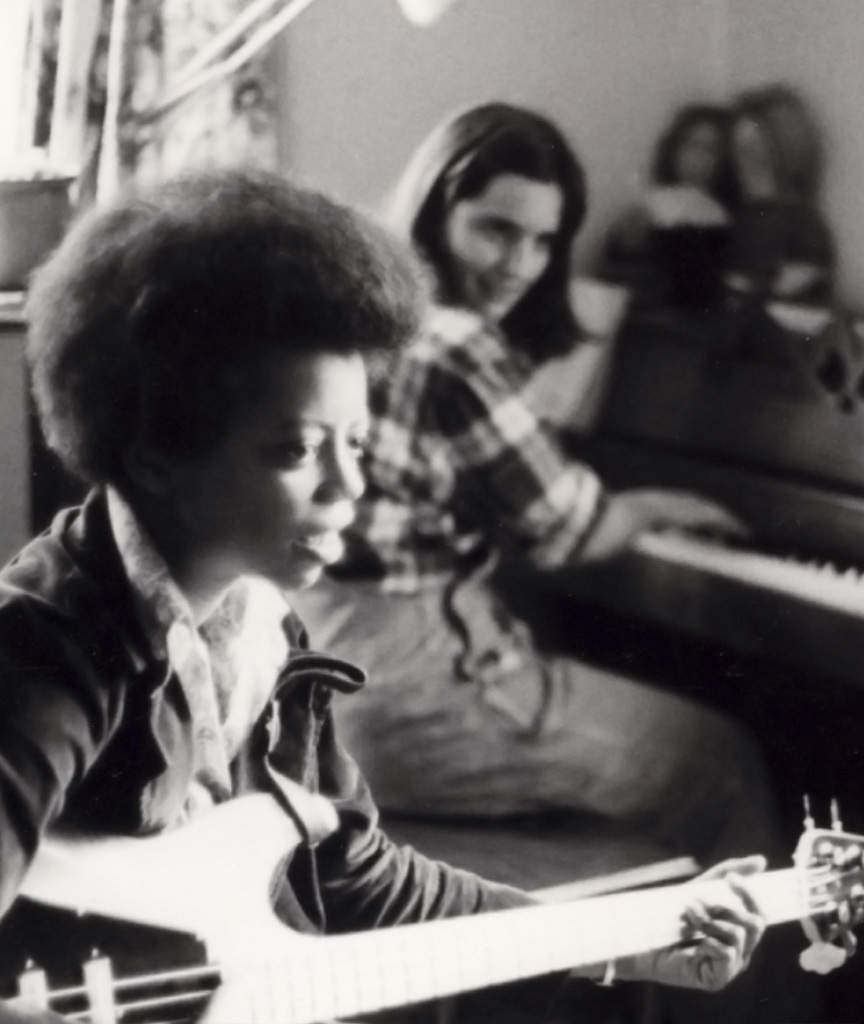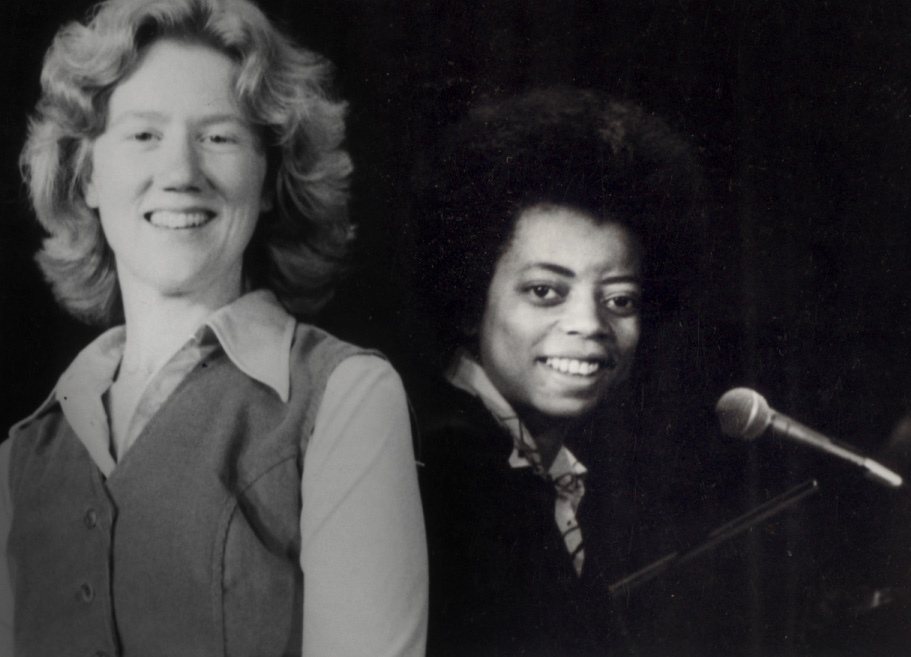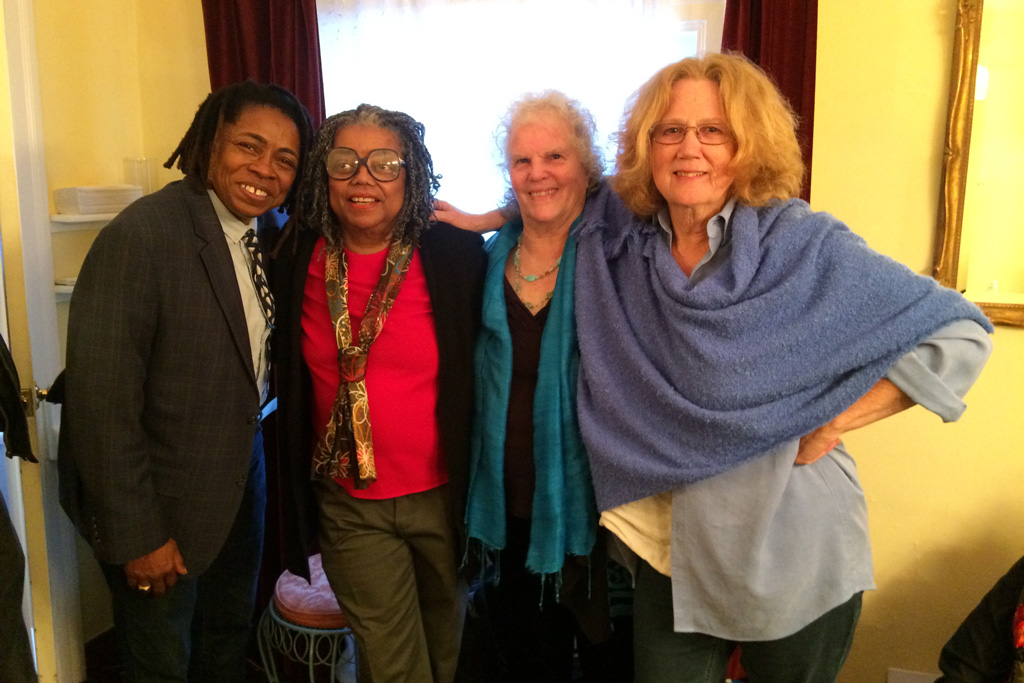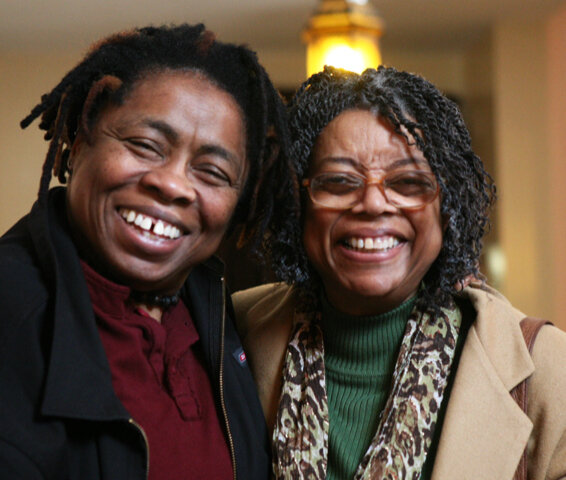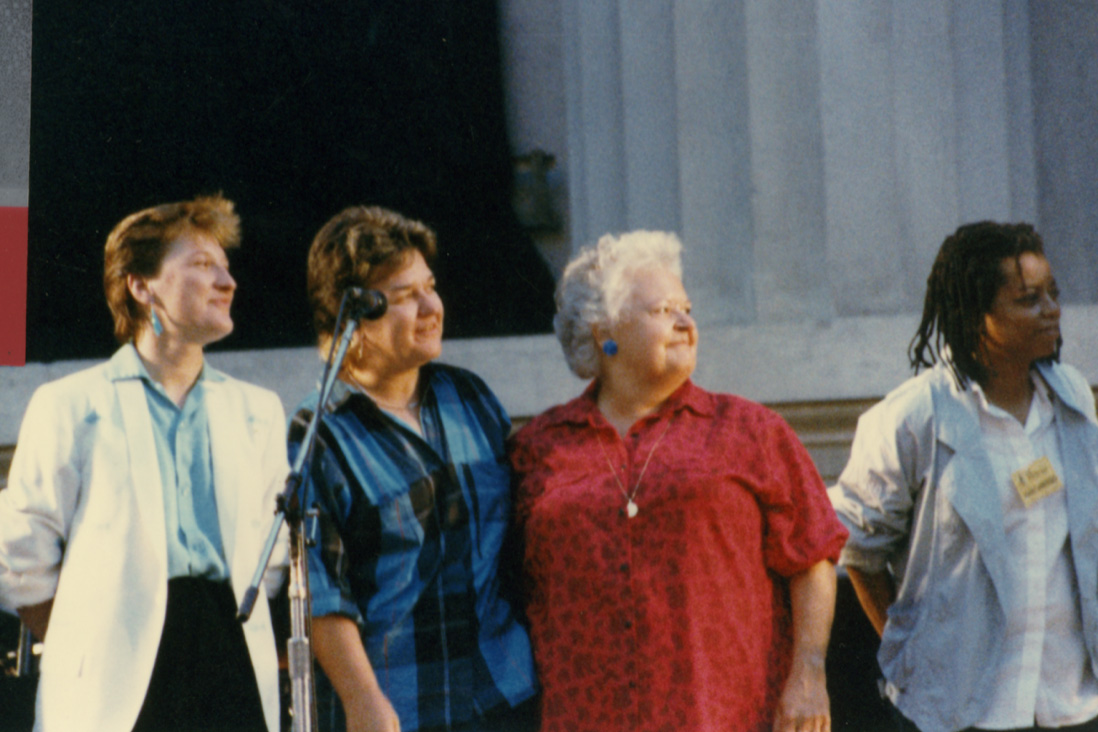Mary Watkins
Short Film by The Understory, Maya Pisciotto & Fabián Aguirre
Mary Watkins
is a musician in the highest sense of the word. Pianist, composer, arranger, performer, and cultural thinker.
Mary trained in classical music at Howard University, but of course, it is what we do with training that defines the artist. Ms. Watkins can sit at the piano while waiting for a sound check to begin, play a two-minute improvised piano solo that takes one’s breath away and then look up and quietly ask for a little more of the mix in her monitor. She has all the notes but it is knowing which ones to call on that makes her work so inspiring. She has written for symphony orchestras, chamber and jazz ensembles, film, theater, dance, choral groups, and folk singers.
Mary’s deep respect for black history and culture led her to write operas: Dark River, based on the story of Civil Rights activist Fanny Lou Hamer and her work with the Student Nonviolent Coordinating Committee; Queen Clara, based on the life of the founder of the Red Cross, Clara Barton; and Emmett Till: The Opera, which tells the story of the 14-year-old African American who was lynched in Mississippi in 1955, after being accused of offending a white woman in her family’s grocery store.
-Mary Watkins
Photo: Irene Young
Mary Watkins was one of the groundbreaking women of color who brought multiple disciplines to what became known as Women’s Music. Like much of the music that comes out of a community’s need to confront oppression and challenge stereotypes, Women’s Music created music that comes from a woman-identified perspective. Mary had experienced the sexism of the jazz world working in Washington DC. When she came out to California, she crossed paths with Holly Near and became her touring accompanist and collaborator. For both of them, this offered an opportunity to look at songs and arrangements from a feminist point of view.
Mary also met women from Olivia Records, a blossoming lesbian feminist record company in Los Angeles. And from that point on, Mary laid the groundwork for a solo career, releasing several recordings. She worked in dozens of collaborations that called on her multiple talents within jazz and folk genres; wrote for Dance Brigade, a feminist dance company; wrote and arranged for women’s choruses and women’s orchestra, all being produced by women’s music circles around the country. Still she didn’t want to get stuck or stereotyped, there, any more than she wanted to be labeled in the jazz world.
And as a result of her wide reach, she became known around the country in multiple music communities. Mary served as music director and composed the musical The Resurrection of Lady Lester, presented at San Francisco’s Lorrain Hansberry Theater.
Mary was invited to be one of five African American composers to present their work with The New Black Music Repertory Ensemble of Chicago. The Ensemble’s series, Music of the African Diaspora, featured Mary’s Five Movements in Color, a suite for orchestra.
She composed music for a theatrical adaptation by Rick Foster, of the Toni Morrison’s book, The Bluest Eye, produced by San Francisco’s Lorraine Hansberry Theatre, 1989.
Mary Watkins has been a long-standing collaborator with Krissy Keefer, artistic director of the Dance Mission Theater and Dance Brigade.
And if you want to know more—as the list goes on and on—go to womenarts.org
Click to view Mary's extensive discography
Albums Composed Entirely by Mary Watkins:
Something Moving (Olivia, 1979)
Winds of Change (Palo Alto Jazz, 1982)
Spiritsong (Redwood Records, 1985)
Prayer For Peace 2003 (Shotsky Music, 2003)
Albums Featuring Compositions or Arrangements by Mary Watkins
The Soul Knows (Wenefil, 1992) – Features traditional hymns, gospels and spirituals
Song For My Mother (CD of jazz trio co-produced with Joyce Kauffman) – Features two Watkins originals (High Tide Music, 1999)
Dancing Souls (LadySlipper, 2000) – flute and piano duo; all music co-created with Kay Gardner
Who Has Not Been Touched (CD of jazz quartet co-produced with Joyce Kauffman) – Features three Watkins originals (High Tide Music, 2004)
Music of the African Diaspora: Five Movements in Color – Suite for orchestra (Albany Records, 2009)
Film Scores
The Wolf; Peter Nicks, UC Berkeley, 2001
Different Colors; KQED public television, 1999
Family Values; Pam Walton Productions, 1995
Skin Deep; Iris Films, 1995
Dream Horse; A Shaffer Travis Production, 1994
Black Is… Black Ain’t; Signifyin’ Works Productions, 1994
Out For A Change; WomanVision, 1994
Complaints Of A Dutiful Daughter; Hoffman Productions, 1994 (Academy Award nomination, 1995, Emmy Award, 1996, Dupont Film Awards, 1996, and numerous others)
Straight From The Heart; WomanVision, 1994 (Academy Award nomination, 1995)
Freedom On My Mind; Clarity Productions (Academy Award nomination, 1995, Sundance Award, 1994)
Valuing Relationships I, II, and III; (Three films) Griggs Productions, 1993
Conversations With Alice Walker; Charles Johnson; Toni Morrison; Gloria Naylor; August Wilson; John Wideman; Six documentary films covering one of each writer for each film, California Newsreel, 1992
The World of O’Brien-Kreitzberg; Koppleman and Associates, 1991
Aids in Africa; Family Health International, 1991 (Black Filmmakers Hall Of Fame)
Ein Stehauf Mannche; Vivian Kleiman Productions, 1991
Color Adjustment; Signifyin’ Works Productions, 1991 (Peabody Award, 1993)
Diversity Among Japanese American Women; The American Japanese Historical Society, 1990
The Coming Ice Age; Ephron Productions, 1988
Fighting For Our Lives; Seidler Productions, 1987
Valuing Diversity: Part I, II, and III; (Three films) Copeland and Griggs Productions, 1987
Ethnic Notions; MTR Productions, 1986 (Emmy Award, 1988, and several other national and international awards)
Grants and Awards
Zellerbach Family Fund (for Dark River development, 2011)
PatsyLu Fund of Open Meadows Foundation (for Dark River, 2011)
Zellerbach Family Fund (for individual artists, 2001)
Meet the Composer Commissioning Program (1993, 1994)
Meet the Composer Commissioning Program (1992, 1993)
California Arts Council Artist in Residence Program (1991/92)
City of Oakland Composer Fellowship (1991)
California Arts Council Composer Fellowship (1991)
Meet The Composer Commissioning Program (1990)
Gerbode Foundation (1989)
Zellerbach Family Fund Composition (1986, 1987, 1988, 2001)
National Endowment for the Arts, Jazz Composition (1987)
Clorox Foundation (1987, 1988)
Oakland Redevelopment Agency Jazz Performance (1986)
Member, California Arts Council Tour Roster (1985)
California Arts Council Touring Program (1985/86, 87/88, 88/89)
Best Composer/Arranger and Best Keyboardist Nomination,
Bay Area Jazz Artist Music Awards (1985)
National Endowment for the Arts Grant, Jazz Performance (1981)
National Endowment for the Arts, Women’s Prison Tour (1980)
Best Debut Album Nomination, Bay Area Music Awards (1979)
Special Projects
Within Our Gates: Toured in 1993 to the Kennedy Center, the Smithsonian Institute, and the International Philadelphia Film Festival as pianist and co-composer (piano and violin) for the silent film of the earliest known full length feature film (1919) by an African American filmmaker, Oscar Micheaux.
The Nutcracker Sweetie: Composed music and integrated it with a jazz adaptation of the classic Nutcracker by Peter Tchaikovsky. The piece was performed as an annual holiday special by San Francisco’s Dance Brigade from 1987-1997.
The Resurrection of Lady Lester: Served as music director and composer for a musical play at San Francisco’s Lorraine Hansberry Theatre, 1988.
The Bluest Eye: Composed music for a theatrical adaptation by Rick Foster, of the Toni Morrison book, The Bluest Eye, produced by San Francisco’s Lorraine Hansberry Theatre, 1989.
Queen Clara: Composed opera based on the life of Clara Barton with libretto by Lance Belville. Produced by Oakland Opera Theater, July 2005.
Dark River: Composed and wrote libretto for an opera based on the life of civil rights activist, Fannie Lou Hamer. Produced by Oakland Opera Theater, 2009.
Scores Published by Shotsky Music
Full Orchestra: Five Movements In Color
Chamber Orchestra: Rag
Chamber Orchestra: Hide N’ Seek
Woodwind Quintet: The Party Line
Flute, Clarinet, Bassoon: Piece For Woodwind Wind Trio (4 movements)
Flute, Clarinet, Cello, and Piano: Piece For Quartet (3 movements)
Flute Solo (Piano Accompaniment): Braziltown USA
Flute Solo (Piano Accompaniment): Patrick The Dancer
Oboe (Piano Accompaniment): Chablet
Trumpet Solo (Piano Accompaniment): Call To Peace
Trumpet Solo (Piano Accompaniment): Mount Cathedral
Violoncello (Piano Accompaniment): The Medium, Focus, and Black Waters
Piano Solos: Music For Young Musicians (3 Books)
Chorus: We Are One (7 movements)
Opera: Dark River, Premiered Nov 14th, 2009, Oakland Opera Theatre; Oakland California
Other Skills
Arranger–Arranged for strings, horns and rhythm, voices. Arranged popular show tunes and standards for various projects. Transcribed, arranged and orchestrated music for songwriters and composers.
Record Producer–Coordinated musicians and studio sessions, worked closely with engineers and featured artists. Managed musical production for seven commercial albums.
Professional Performer/Pianist–Performed professionally on acoustic piano, electric piano, synthesizer, and other keyboards. Work consisting of nationwide solo piano concerts, trio, quartet, and quintet/sextet performances. Church Pianist/Organist.
Teacher–Taught private music lessons in theory, improvisation, piano. Taught jazz piano at Holy Names College, Oakland, CA 1994-1997.
Education
Howard University, Bachelor of Music (cum laude), Washington, D.C., 1972.
A Personal Note From Holly
I was not real comfortable at first with Mary. I’m a talker, she is not. . . unless one shuts up long enough and then she is a great talker with humor and fascinating ideas and stories about her life. When I finally learned to be comfortable with the silence, I became the benefactor of so much musical wisdom and world observations. So I think it is fair to say I got better at listening when I toured with Mary—not only in conversation but in the way she made her way through the songs. She was not afraid of the silence, the spaces. I was used to my accompanists having a strong rhythmic presence, so I didn’t really have to think about rhythm except for how the lyrics presented rhythm through consonants (the drums) and vowels (the violins). Mary didn’t always play “the beat”. She played as if there was some universal understanding as to where lived the beat. At first, I had to keep time with my toes inside my shoe so people couldn’t see me counting. And then I fell in love with the space—the unspoken heartbeat. I can remember “blaming” Mary at first, that she wasn’t giving me enough of what I needed. Fair enough. Singers have a right to ask for what they need and for sure, when interpreting a song, one doesn’t want to be worried about keeping time. But fortunately, I moved though my insecurity and I let go of needing a metronome in her left hand. I began to study what it was Mary was hearing. She was a master class.
A conversation with Mary Watkins and Holly Near
Filmed on location at Freight & Salvage in Berkeley, California, 2019


